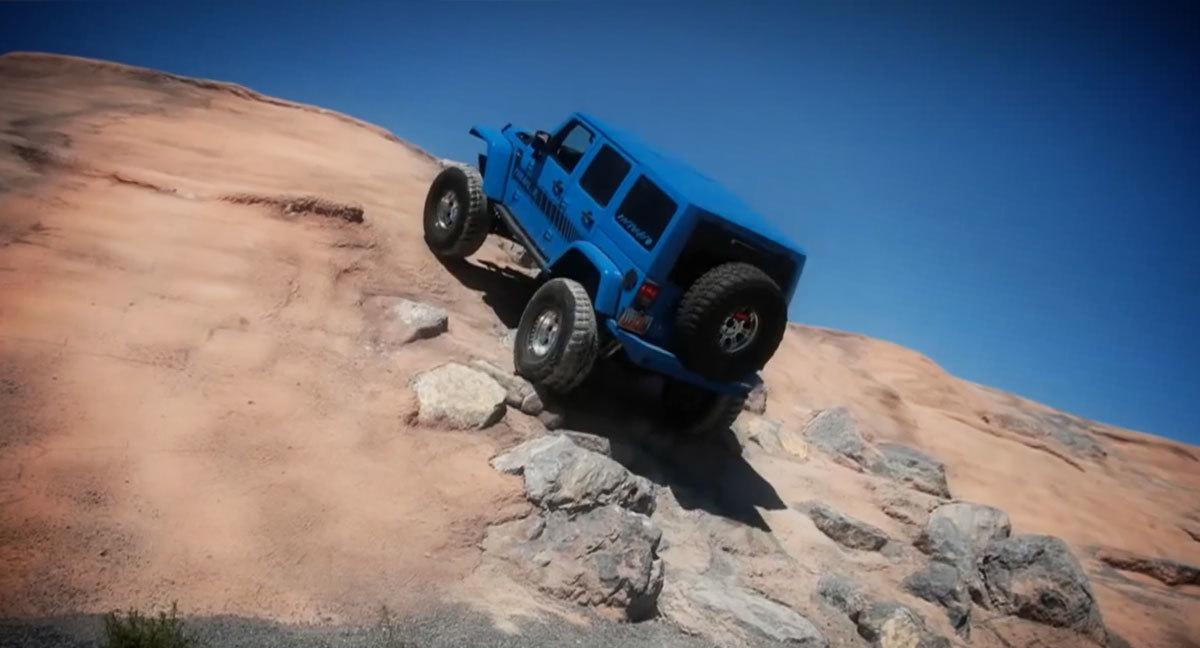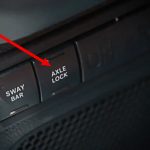A wheel has lost traction and you can't move forward. What are your options?

When folks get behind the wheel of a brand-new Jeep, they usually aren’t aware of its useful built-in capabilities. Lockers, sway bars, high-range gearing, and low-range gearing. All this stuff is useful, but when and how should it be used? If you’re just using your Jeep for the daily grind, you’ll probably never need to press any of these handy-life buttons, such as the AXLE LOCK button.
A basic 4-door Jeep Wrangler Unlimited Rubicon will help us illustrate the functionality of the selectable locking differentials, and how to use them.
2-Wheel-Drive
 When attempting to negotiate a series of off-road obstacles in two-wheel drive (2WD), plenty of flex helps maintain tire contact. But when one wheel finally loses traction, power is transferred to the path of least resistance, or the tire with the least amount of ground contact and traction. This leaves a useless free-spinning wheel and halted forward motion. Thus, the open differential at work. In reality, 2WD has just become one-wheel drive (1WD).
When attempting to negotiate a series of off-road obstacles in two-wheel drive (2WD), plenty of flex helps maintain tire contact. But when one wheel finally loses traction, power is transferred to the path of least resistance, or the tire with the least amount of ground contact and traction. This leaves a useless free-spinning wheel and halted forward motion. Thus, the open differential at work. In reality, 2WD has just become one-wheel drive (1WD).
In the days before lockers, there was a technique that will still sometimes yield just enough assistance to get you out of this situation. While maintaining throttle pressure, press and hold the park brake release button. Now sharply pull and release the parking brake, pumping up and down in rapid succession. This causes a bouncing effect directly on the spinning tire desperately searching for traction, increasing resistance, which forces power back to the tire with traction, resulting in forward motion. This technique is like what your JK Jeep JK Wrangler’s Brake Lock Differential System can perform.
2-Wheel-Drive with Rear Lockers
With the dawn of the locking differential, a new world of traction was opened. Assuming the Jeep is immobile as before, still in 2WD (though acting as 1WD once again), this time instead of our park brake technique we simply engage the rear locker. Normally in a stock Jeep Rubicon we would need to be in 4-Low (four-wheel-drive Low) to engage the rear locker, and then press the AXLE LOCK button once to engage the rear differential. Instead, for this example, we will use a Jeep equipped with an ARB selectable locker to illustrate the rear locker. An ARB selectable locker can be actuated at any time. To engage, press the ARB COMPRESSOR switch, and then the REAR AIR LOCKER switch. Now the “open” differential has become closed, the wheels are locked, and power is equally distributed to both wheels, resulting in forward motion.
If lockers are so great, why don’t people use them all the time? Well, consider both tires connected by a single solid axle shaft, wheels locked together. In a tight turn, the inside tire will want to rotate much slower than the tire on the outside, but with the axle locked, both tires are forced to turn at the same speed. This results in a tire annihilating drag, accompanied by the associated barking and squealing of the inside tire. How did they correct that problem? The solution is in the open differential.
The open differential is designed to allow independent rotation of the tires. Inside the differential, power is transferred to the path of least resistance. This will often result in a 1WD scenario as illustrated in the previous example. For example, if one tire is on solid rock and the other is on loose dirt, power transfers to the one in loose dirt, which is the path of least resistance.
In our tight turn scenario, an open differential supplies power to the outside tire, while the inner tire free-wheels, or coasts. This allows the outer wheel to rotate much faster than the inner wheel, resulting in a smooth turn. Although having a locked rear differential can yield better results in certain situations than even 4WD, there are times when there is no substitute for 4WD.
4-Wheel-Drive
4WD with open differentials supplies power to both the front and the rear axles. Now, remember, we have open differentials, so power is being supplied to the wheels with the least resistance. In 4WD, that means three-wheel-drive (3WD) or 2WD when tires lose traction. However, 4WD is still a very effective off-road combination. With the right driver, a no-locker or open differential Jeep is still a largely capable vehicle that can often clear a steep obstacle just fine.
4-Wheel-Drive with Lockers
Now if we attempt that steep obstacle-ridden hill, but this time with both axles locked, we truly have 4WD. All tires are turning at the same rate. This means 100% of the power is supplied to the tires with the greatest resistance and traction. Of course, this sounds great until you hear the sound of parts breaking — be careful when you’re locked up. Avoid bouncing and a heavy foot. Disengage the lockers when you don’t need them. Steering is far better when they’re open.
To engage the lockers in 4WD in a stock Rubicon (no ARB selectable locker installed), shift the transfer case to 4-Low. Now simply press the AXLE LOCK button once to engage the rear locker and this time press it once more to engage the front axle’s locker. NOTE: when the front and rear lockers are both engaged, you can toggle the lockers on and off with each subsequent press of the AXLE LOCK button. Watch for the orange indicator lights on the dash, between the speedometer and tachometer. With the transmission in NEUTRAL, give the locker about 15 seconds to fully engage.
Now you’re ready to take that obstacle.






